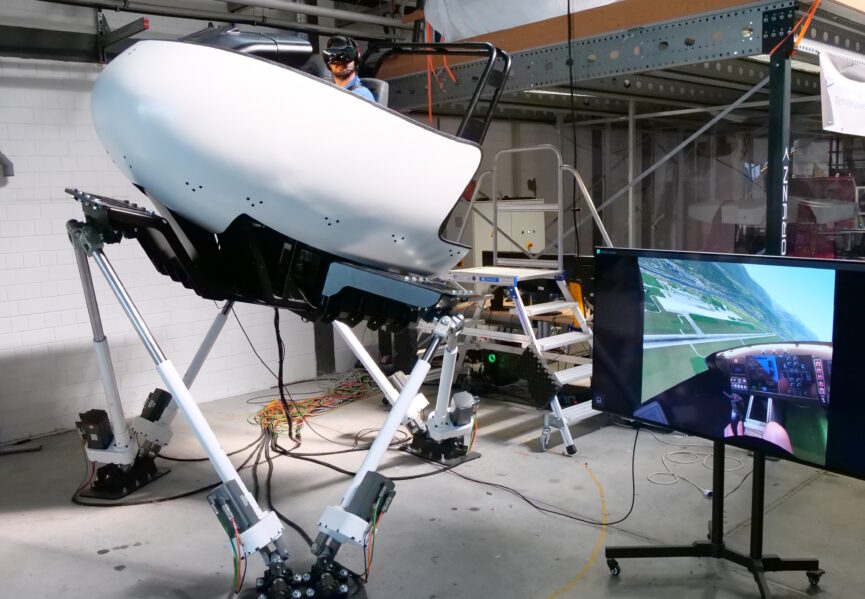On this page you can learn more about our four flight simulators:
- Mixed Reality Full-Motion eVTOL Flight Simulator
- Diamond DA42 Flight Training Device
- Beech Baron C-58 Flight Simulator
- Research Flight Simulator
- Lecture Flight Simulator
Mixed Reality Full-Motion eVTOL Flight Simulator
Advanced Air Mobility vehicle designs entail novel control and cockpit concepts. Consequently, robust, flexible and advanced flight simulators are highly valuable. Our eVTOL research simulator introduces a setup using Mixed Reality (MR) to blend virtual and physical elements, creating a realistic and adaptable cockpit environment. Advanced MR features, like virtual cockpit windows and a stable tracking algorithm, further enhance this concept. The design focuses on modularity and expandability to provide a tool that can evolve with changes in human-machine interface technology. An expert evaluation resulted in recommendations and guidelines for integrating an MR flight simulator in research, aircraft development and pilot training. [1]
 Mixed Reality Full-Motion eVTOL Flight Simulator
Mixed Reality Full-Motion eVTOL Flight Simulator
Diamond DA42 Flight Training Device
The DA42 FTD was built with original aircraft components from Diamond Aircraft to achieve a realistic cockpit environment. It has an accurate replication of aircraft flight dynamics and systems and is certifiable up to FTD Level 6 according to 14 CFR Part 60.
The simulator is used for the flight guidance training of students as well as for research purposes. Main advantages for students are the state-of-the-art glass cockpit and the control loading system, which provides highly realistic control forces corresponding to every flight condition. By using the DA42 flight training device, it is possible to offer up-to-date training, utilizing all technical possibilities such as GPS based area navigation, FAA WAAS Certified Approaches, moving map, Garmin G1000 (together with the Synthetic Vision Technology) and the modern digital auto pilot system Garmin GFC 700.
Beech Baron C-58 Flight Simulator
The Beech Baron 58 simulator is used for the practical course Flight Guidance. It was originally planned, designed and constructed by students in their diploma theses. The fuselage is an actual Beech Baron C-58 aircraft that was damaged beyond repairs by heavy storms when parked on the ground. The flight controls (yoke, engine quadrant) are also from the original aircraft. The instruments are rendered using SCAMSY, providing the original look of the instruments. This simulator serves as the workhorse for us to teach the basics of instrument flying to engineering students.
Research Flight Simulator
The research Flight Simulator was originally developed in 2000 in cooperation with Fairchild Dornier, who donated the shell. Since the main purpose of this simulator is research, it has a generic cockpit with big screens and standard PC-Hardware to achieve high flexibility and modularity. It features a Three-Channel visual system with over 180° viewing angle and Full-HD resolution for each channel. The cockpit has one active side stick made by Wittenstein, which includes an electronic control loading system to allow force feedback and variable hard- and softstops. Due to the cooperation with Fairchild Dornier, the Flight Dynamic Model is based on a high-fidelity aerodynamic and engine industry data set and is implemented in MATLAB Simulink.

Lecture Flight Simulator
This mobile flight simulator setup was developed at our institute for interactive demonstrations during flight control lectures and tutorials. It is comprised of commercially available flight simulation software, for which a plug-in has been developed that allows access to the aircraft’s data. Furthermore, primary and secondary control devices (stick alternatively yoke) and a mode control panel are available. The simulation PC is connected via Ethernet to a laptop, on which MATLAB/Simulink is configured to communicate with the flight simulation software.
This setup allows for realistic demonstration of analysis and modeling methods, as well as controller design algorithms. The PC section is used as black-box aircraft model, which can be analyzed in a first step. In a second step, controllers are then implemented and tuned live on the external laptop.
Educational Use
- Determining steady-state flight conditions through trim routines
- Linearization to create linear state space models
- Analysis of the received data with Matlab
- Implementation of gain design routines
- Stability and Control Augmentation Systems
- Autopilots, Auto Thrust, Automatic Landing
- Flight testing for system identification
- Determination of linear state space models from flight test data

Literature
[1] M. Zintl, S. Kimura and F. Holzapfel, “A Mixed Reality Research Flight Simulator for Advanced Air Mobility Vehicles”, in AIAA AVIATION FORUM AND ASCEND 2024 [doi]




